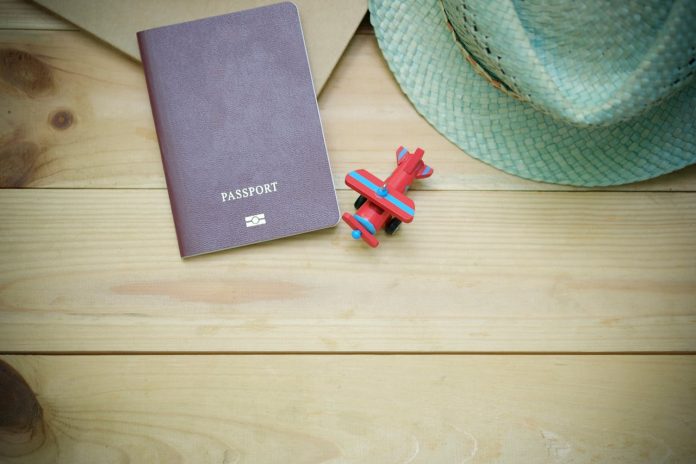Are you considering studying abroad but aren’t sure what type of visa you’ll need? Well, the process of selecting the appropriate visa can be complicated, but we’re here to help you.
In this blog post, we’ll look at the various types of Visas available including student visas meant for educational goals. We will also help you determine which one is best for you.
That’s not all, we’ll discuss the requirements for these visas and offer some advice on how to make the application process as simple as possible so keep scrolling.
But before we proceed, let’s quickly answer a question that a lot of people ask “What is a visa?”
What is a Visa?
A visa is an official document that allows people to enter or stay in another country for a specific length of time. It functions as an authorization, much like an exclusive pass, signifying that the bearer is permitted to travel or reside in a specific country.
Obtaining a visa guarantees that persons follow the restrictions and guidelines established by the destination country. Visas vary in duration and purpose; some are intended for brief trips, while others allow for longer stays.
In essence, a visa is an official invitation that allows legitimate entry into another country.
Also Read: Top Reasons to Study in the UK
Types of Student Visas for Your Educational Goals
There are various types of student visas that allow international students to further their education. These visas are classified as F, M, and J visas. Read on to learn more about these visas.
F Visa
Below are the categories of F Visa:
F1 visa
The F1 visa is the most common type of Vias, and it is meant for full-time students undertaking academic programs at authorized institutions such as universities or colleges.
To be eligible for an F1 visa, students must have a valid admission letter from their educational institution and show that they have the finances to cover their expenditures while studying in the United States.
F1 visa holders can work part-time on campus throughout their studies and may be eligible for Optional Practical Training (OPT) when they finish their program.
F-2 Visa
The F2 visa is for F1 visa holders’ dependents, including spouses and unmarried children under the age of 21.
F2 visa holders are not permitted to work in the United States, however, they may accompany F1 students while studying.
F2 visa holders must retain their dependent status and avoid any unauthorized employment or academic studies.
F-3 Visa
F3 visas are family-sponsored visas for married children of F1 visa holders.
To qualify for the F3 visa, the married child must be sponsored by their F1 visa-holding parent.
F3 visa holders, like F2 visa holders, are not permitted to work in the United States and must prioritize family ties.
Related: English Language Proficiency Test Success Tips
M Visa
M visa is another type of student visa in the United States. These visas are obtained by students pursuing non-academic or vocational degrees. Below are the categories of M Visa:
M-1 Visa
The M1 visa is for students attending vocational or technical schools. Individuals with a desire for hands-on learning, such as carpentry or mechanics, may apply for an M1 visa.
To obtain an M1 visa, students must be admitted to a recognized vocational school and demonstrate that they have the financial resources to finance their education and living expenses.
M1 visa holders are not permitted to work while enrolled in school, however, they may participate in practical training following graduation.
M2 Visa
The M2 visa is for M1 visa holders’ dependents, which include spouses and unmarried children under the age of 21.
While M2 visa holders are not permitted to work, they may accompany an M1 student during the term of education.
It’s crucial to remember that M2 visa holders should prioritize their dependent status and avoid unauthorized employment or academic pursuits.
M3 Visa
M3 visas are family-sponsored visas for married offspring of M1 visa holders.
To be eligible for an M3 visa, the married child must be sponsored by the parent who has the M1 visa.
M3 visa holders, like those on the M2 visa, are not permitted to work in the United States. Their primary attention should be on keeping family ties and following visa restrictions.
J Visa
In the United States, there is a special visa known as the J Visa, which is obtained by those participating in exchange visitor programs. Below are the categories of J-1 visas.
J-1 Visa
The J1 visa is obtained by those participating in exchange programs, such as students, scholars, or work and travel programs.
To get a J1 visa, applicants must be sponsored by an approved exchange program and indicate their intention to return to their home country once the program is completed.
J1 visa holders are permitted to work on projects linked to their program and may be qualified for practical training.
J1 visa holders must complete the objectives of their exchange program while adhering to visa requirements.
J-2 Visa
The J2 visa is for J1 visa holders’ dependents, which include spouses and unmarried children under the age of 21.
While J2 visa holders are not permitted to work without specific authorization, they may accompany the J1 visa holder on their exchange program.
Maintaining the J2 dependent status is critical, and individuals should avoid unauthorized jobs and academic study.
Now, you’ve known the different types of visas available for final goals but what do you need to apply for these visas? Read on to find out in the next section.
Student Visa Requirements
Below are the main requirements for a student visa;
Acceptance Letter
To obtain a student visa, you will require an acceptance letter from a recognized institution indicating that you have been accepted for studies.
Financial Proof
You must also establish that you have enough finances to cover your tuition and living expenses. This is to convince officials that you will not have financial difficulties during your study.
Valid passport
A valid passport is equivalent to a travel ticket. It is a required document for foreign travel. Make sure it is valid for the entire course of your study.
Visa Application Form
This is an official document in which you submit information about yourself, your studies, and your plans in the United States. You will have to fill it out and submit it to the authorized officials.
Health Insurance
Health insurance is a very important requirement for students who want to study in the United States.
It is a must to ensure that you have access to medical treatment while in the United States. It’s more like having a contingency plan for unexpected occurrences.
As you can see, there are lots of visas you can acquire for your educational goals but what if you do not intend to get a visa for your educational goals? Can you get another type of visa?
Well, the short answer is yes. There are other types of visas you can obtain and we will discuss that in the next section so keep scrolling.
Related: Benefits of Studying Abroad for Your Education and Career Goals
Other Types of Visa
Aside from student visas, there are other types of visas you can acquire, and they include;
Finance and Spouse Visas
In the United States, couples who are engaged or married can obtain special visas that allow them to stay together and develop their life in the country. Below are the categories of these types of visas;
K-3 Visa
The k3 visa is meant for spouses of US citizens. If a person is married to a US citizen and wants to live in the United States while their immigrant visa application is processed, they can apply for a K3 visa.
K3 visa holders can stay in the United States for up to two years, during which time they can apply for a green card and become permanent residents.
IR1 and CR1 visas
IR1 and CR1 visas are also available for spouses of US citizens, but only for couples in which the foreign spouse seeks permanent status.
The IR1 type of visa is for couples married for more than two years, and the CR1 visa is for those married for less than two years.
Both visas allow the foreign spouse to enter the United States as a permanent resident.
This implies they can live and work in the United States immediately after arrival.
K-4 visas
The K-4 visa is meant for unmarried children under the age of 21 whose parents have K-3 visas.
It allows these children to accompany their parents to the United States and join the family.
K-4 visa holders can study and live with their parents while the immigration procedure is ongoing.
It’s a family-friendly visa that allows youngsters to be with their parents during this critical time.
Transit and Crewmember Visas
These are unique types of visas specifically meant for persons in transit or operating on ships or aircraft. Below are the categories of these types of visas;
D Visa
The D visa is for anyone traveling from the United States to another country. It can also be used by nationals of different countries.
D visa is typically used for travelers who have a brief stopover or layover on their journey.
The D visa permits travelers to stay in the United States for a short period, whether for tourist or transit.
However, holders of the D visa are not permitted to work throughout their stay.
C Visa
The C visa, often known as the Crewmember visa, is for people working on ships or airplanes.
This comprises flight attendants, pilots, and maritime staff. The C visa allows individuals to enter the United States temporarily for work-related reasons.
Crewmembers are expected to leave the United States on the same ship or aircraft that they arrived on.
This visa is limited to their employment tasks and does not allow them to engage in any other activities outside of work.
Victims of Crime and Human Trafficking Visas
Individuals who have been victims of crime or human trafficking are eligible for these types of visas. Below are the categories of this type of visa;
T Visa
The T visa is meant exclusively for victims of human trafficking. If someone has been taken to the United States against their choice or has suffered serious exploitation, they may be eligible for a T visa.
This visa allows victims to stay in the United States temporarily and allows them to assist law enforcement in investigating and prosecuting trafficking offenses.
T visa holders can also seek permanent residency after a specified period, which will provide them with a more secure and long-term presence in the country.
U Visas
The U visa is for victims of specific crimes who have experienced mental or physical abuse and are prepared to help law enforcement with the investigation or prosecution of the crime.
This encompasses crimes including domestic abuse, sexual assault, and human trafficking. The U visa grants victims temporary immigration status and permits them to work in the United States for up to four years.
Furthermore, U visa holders may be eligible to seek permanent residency after a set length of time, paving the way for a more stable life in the United States.
Also Read: Importance of Civic Education
Diplomatic and Official Visas
These types of visas are allocated to those serving in diplomatic or official capacity. Category of this type of visa include;
A-1 Visa
The A1 visa is awarded to those who represent foreign governments at the highest levels. This comprises ambassadors, ministers, and other high-level officials.
The A1 visa allows them to enter the United States for official responsibilities and activities. It is a recognition of their diplomatic standing, allowing them to carry out their duties smoothly.
Holders of the A1 visa are usually members of the embassy or consular service.
A2 NATO1-6 Visa
The A2 NATO1-6 visa is meant for representatives of NATO and other international organizations. This visa allows them to enter the United States for official purposes and activities.
The A2 NATO1-6 visa is divided into subcategories (NATO1–NATO6) based on the individual’s unique job and rank within the organization. It recognizes and facilitates their diplomatic responsibilities, much as the A1 visa does.
G-1 to G-5 Visa
Individuals working for international organizations or representing foreign governments are eligible for G visas ranging from G-1 to G-5.
The G-1 to G-5 visas cover a wide range of positions, from high-ranking officials to support personnel. These types of visas allow them to live and work in the United States while fulfilling official duties.
G visa holders help to strengthen diplomatic connections and international cooperation.
Treaty Trader and Investor Visas
This type of visa is meant for those involved in trade and investment, which promotes international business partnerships. Below are the categories of treaty trader and investor visas;
E1 visa
The E1 visa, also known as the Treaty Trader visa, is for those who are involved in substantial trading between the United States and their native nation.
An E1 visa requires the existence of a treaty of commerce and navigation between the United States and the individual’s home country.
This visa allows traders to enter the United States to undertake and oversee trade-related operations.
E-2 Visa
The E2 visa, also known as the Treaty Investor visa, is designed for persons who make a large investment in a U.S. business.
The E2 visa, like the E1 visa, needs a treaty between the individual’s nation and the United States. The investment must be large and generate work opportunities for US citizens.
The E2 visa enables investors to actively manage and lead their investments in the United States.
Exchange Visitor Visas
These are special visa categories designed for persons participating in exchange programs and cultural endeavors. Below are the categories for this type of visa;
J-1 Visa
The J1 visa, often known as the Exchange Visitor visa, is designed for those taking part in exchange programs in the United States.
These programs serve a diverse population, including students, academics, and participants in work and travel projects.
Individuals seeking a J1 visa must be sponsored by an approved exchange program.
The J1 visa not only allows for brief residence but also promotes cultural exchange. It allows individuals to expand their knowledge and abilities while also sharing their culture with the US population.
Q Visa
The Q visa is meant for those taking part in international cultural exchange programs.
This visa category promotes the exchange of traditions, languages, and cultures by allowing individuals to travel to the United States for practical training, employment, and cultural exchange.
Q visa holders contribute to the diversity of American society through active participation in cultural exchange programs.
This enriching experience benefits both the participants and the communities they are a part of throughout their time in the United States.
Visitor Visas
Visitor visas are meant for persons who want to visit the United States for business or tourism. Here are the categories of visitor’s visas;
B-1 Visa
The B1 visa, often known as the Business Visitor visa, is for those doing business in the United States.
The B1 visa allows travelers to engage in specific business activities, such as attending conferences, negotiating contracts, or participating in professional events.
It is a temporary visa that recognizes the value of international business relationships and allows individuals to contribute to commercial endeavors while in the United States.
B-2 Visa
The B2 visa is for persons who wish to visit the United States for tourism or recreational purposes.
Individuals with a B2 visa can go sightseeing, visit friends and relatives, or engage in leisure activities.
This visa category recognizes the importance of tourism and cultural exchange, promoting links between people from all origins.
Immediate Relative & Family Sponsored Visas
These are special types of U.S. visas meant to reunite families and enhance relationships between near relatives and family members who sponsor them. Category of this type of visa include;
F2A and F2B visas
The F2A visa is meant for spouses and unmarried children under the age of 21 who are Lawful Permanent Residents(LPR).
On the other hand, the F2B visa is intended for unmarried children of LPRs over the age of 21.
Both visas demonstrate a commitment to family unity by allowing relatives to join their Lawful Permanent Resident family members in the United States.
IR2 and IR5 visas
The IR-2 visa is for unmarried children under the age of 21 who are US citizens. Meanwhile, the IR5 visa is for parents of US residents who are 21 or older.
These visas emphasize the value of family relationships by allowing unmarried children and parents to join their US citizen family members.
F1, F3, and F4 visas
The F1 visa is for unmarried sons and daughters of United States citizens, whereas the F3 visa is for married sons and daughters of US citizens. The F4 visa is for brothers and sisters of adult US citizens.
These family-sponsored visas also exemplify the commitment to family unification, accommodating various familial relationships and dynamics.
IR3, IH3, IR4, and IH4 visa
IR3 and IH3 visas are for orphans adopted abroad by US residents. The IR4 and IH4 visas are for orphans to be adopted in the United States.
These visas highlight the humane side of immigration, allowing orphans to find loving and supportive family environments in the United States.
Temporary Work Visas
These types of visas are for people seeking temporary employment possibilities in the United States. Below are the various categories of temporary work visas
H-1B Visa
The H1B visa is meant for workers in specialty occupations such as science, technology, engineering, and mathematics (STEM).
It enables professionals to work temporarily in the United States for up to six years, beginning with a three-year tenure that can be extended.
H1B visa holders frequently provide their specialized expertise to US companies.
H1B-1 Visa
The H1B1 visa is a variant specifically for citizens of Singapore and Chile and offers similar opportunities as the H1B visa.
It is designed for those who operate in specialized fields and helps them find temporary work in the United States.
H-2A visas
The H-2A visa is meant for temporary agricultural laborers. It allows foreign nationals to labor in the United States to fill seasonal or temporary agricultural positions where domestic workers are in limited supply.
H-2B Visa
Similar to the H-2A visa, the H-2B visa addresses temporary employment needs that go beyond agriculture.
It applies to non-agricultural jobs such as hospitality, landscaping, and construction, where companies face a shortage of domestic workers.
H-3 visas
Individuals seeking to improve their skills in a certain profession can take advantage of training possibilities in the United States with the H-3 visa.
It’s frequently used for practical training that isn’t available in the person’s native country.
L-1 Visa
The L1 visa is for intra-company transferees, which allows international personnel to work temporarily in the United States.
It consists of L1A for managers and executives and L1B for personnel with specialized knowledge.
O visas
O visas are meant for people with exceptional qualities or accomplishments in disciplines such as the arts, sciences, education, business, or athletics.
The O category covers three types of visas: O1 for the principal applicant, O2 for necessary support people, and O3 for immediate family members.
P visas
P visas are for sports, entertainers, and artists. This category includes P1 for athletes and entertainers, P2 for artists and entertainers participating in reciprocal exchange programs, and P3 for artists or entertainers wishing to perform, teach, or coach in culturally distinct programs.
R1 Visa
The R1 visa is for religious professionals and allows them to work temporarily in religious occupations such as pastors, religious teachers, and religious counselors.
TN/TD visas
TN/TD visas are issued under the North American Free Trade Agreement (NAFTA) and are available to Canadian and Mexican citizens. TN visa is for professionals from Canada and Mexico, and TD visa is for their dependents.
E-3 Visa
The E3 visa is mainly for Australian residents seeking employment in specialty occupations in the United States. It is similar to the H1B visa above but only applies to Australians.
I Visa
The I visa is for foreign media personnel, such as journalists, correspondents, and film crews, and allows them to work temporarily in the United States to cover news events or produce documentaries.
SQ Visas
The SQ visa is for eligible S visa applicants who have helped US law enforcement solve criminal offenses. It offers them temporary protection and the ability to work in the United States.
5 Things to Know About Applying for a Visa
Now, you have known the various types of visas available and you’re obviously thinking of getting a visa but wait there are very important things you should know about getting a visa and we will discuss them in this section so keep scrolling.
Here are important facts about getting a Visa;
Choose the Right Visa Type
When applying for a visa, it’s important to choose the appropriate category for your purpose. Visas are classified into various categories as you’ve seen above.
Make sure to choose the one that corresponds to your intentions for visiting. Each visa category has unique criteria, so double-check and choose cautiously.
Follow the Rules and Guidelines
To increase your chances of a successful visa application, carefully study and adhere to all of the embassy or consulate’s rules and instructions.
These guidelines frequently include required documents, application forms, and other pertinent information. Ignoring these requirements may cause delays or, worse, visa refusal.
Submit Accurate and Complete Information
Provide accurate and complete information while filling out your visa application. Do well to provide accurate and comprehensive information in all forms.
Any inconsistencies or missing information may result in problems or visa denials. Double-check your application to confirm that all personal information, travel history, and financial records are correct and up to date.
Start Early and Plan Ahead
To ensure a smooth visa application procedure, start early and plan ahead of time. Delays may arise as a result of numerous application forms, additional document requests, or unforeseen situations.
To avoid last-minute stress, plan ahead of time and give yourself plenty of time to obtain the relevant documents.
Be Prepared for an Interview
Some visa applications need an interview with a consular officer. Prepare to answer questions regarding your trip itinerary, the purpose of the visit, and other pertinent information.
Dress appropriately and have all required documentation with you. Confidence and honesty during the interview can improve the outcome of your visa application.
(Types of Visa) Conclusion
Whether you’re planning to study, work, or visit a relative in the United States, there are numerous types of visas available for you.
All you have to do is to choose from the different types of visas above, ensure that you have all of the appropriate documents intact, and then apply using the tips we’ve provided.





